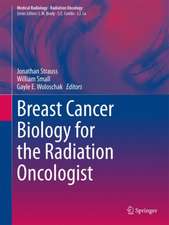Phosphoinositide 3-kinase in Health and Disease: Volume 1: Current Topics in Microbiology and Immunology, cartea 346
Editat de Christian Rommel, Bart Vanhaesebroeck, Peter K. Vogten Limba Engleză Paperback – 7 noi 2012
| Toate formatele și edițiile | Preț | Express |
|---|---|---|
| Paperback (2) | 1411.17 lei 6-8 săpt. | |
| Springer Berlin, Heidelberg – 7 noi 2012 | 1411.17 lei 6-8 săpt. | |
| Springer Berlin, Heidelberg – 3 dec 2012 | 1411.17 lei 6-8 săpt. | |
| Hardback (2) | 1415.75 lei 6-8 săpt. | |
| Springer Berlin, Heidelberg – oct 2010 | 1415.75 lei 6-8 săpt. | |
| Springer Berlin, Heidelberg – oct 2010 | 1423.95 lei 6-8 săpt. |
Din seria Current Topics in Microbiology and Immunology
- 18%
 Preț: 962.03 lei
Preț: 962.03 lei - 5%
 Preț: 1123.13 lei
Preț: 1123.13 lei - 5%
 Preț: 1085.92 lei
Preț: 1085.92 lei -
 Preț: 499.76 lei
Preț: 499.76 lei - 5%
 Preț: 967.79 lei
Preț: 967.79 lei - 18%
 Preț: 1118.62 lei
Preț: 1118.62 lei - 5%
 Preț: 717.00 lei
Preț: 717.00 lei - 5%
 Preț: 712.97 lei
Preț: 712.97 lei - 5%
 Preț: 709.51 lei
Preț: 709.51 lei - 5%
 Preț: 709.51 lei
Preț: 709.51 lei - 5%
 Preț: 721.19 lei
Preț: 721.19 lei - 5%
 Preț: 359.78 lei
Preț: 359.78 lei - 5%
 Preț: 711.88 lei
Preț: 711.88 lei - 5%
 Preț: 774.81 lei
Preț: 774.81 lei - 15%
 Preț: 640.06 lei
Preț: 640.06 lei - 5%
 Preț: 717.00 lei
Preț: 717.00 lei - 5%
 Preț: 360.34 lei
Preț: 360.34 lei - 5%
 Preț: 707.69 lei
Preț: 707.69 lei - 5%
 Preț: 717.56 lei
Preț: 717.56 lei - 5%
 Preț: 716.28 lei
Preț: 716.28 lei - 5%
 Preț: 717.20 lei
Preț: 717.20 lei - 5%
 Preț: 711.32 lei
Preț: 711.32 lei - 5%
 Preț: 711.88 lei
Preț: 711.88 lei - 5%
 Preț: 718.29 lei
Preț: 718.29 lei - 5%
 Preț: 709.51 lei
Preț: 709.51 lei - 5%
 Preț: 369.84 lei
Preț: 369.84 lei - 5%
 Preț: 712.25 lei
Preț: 712.25 lei - 5%
 Preț: 716.45 lei
Preț: 716.45 lei - 5%
 Preț: 706.60 lei
Preț: 706.60 lei - 5%
 Preț: 711.52 lei
Preț: 711.52 lei - 5%
 Preț: 713.54 lei
Preț: 713.54 lei - 5%
 Preț: 720.47 lei
Preț: 720.47 lei - 5%
 Preț: 725.42 lei
Preț: 725.42 lei - 5%
 Preț: 708.06 lei
Preț: 708.06 lei - 5%
 Preț: 713.70 lei
Preț: 713.70 lei - 5%
 Preț: 705.83 lei
Preț: 705.83 lei - 5%
 Preț: 710.96 lei
Preț: 710.96 lei - 5%
 Preț: 723.93 lei
Preț: 723.93 lei - 5%
 Preț: 707.69 lei
Preț: 707.69 lei - 5%
 Preț: 715.35 lei
Preț: 715.35 lei - 5%
 Preț: 709.87 lei
Preț: 709.87 lei - 5%
 Preț: 359.05 lei
Preț: 359.05 lei - 5%
 Preț: 374.20 lei
Preț: 374.20 lei - 15%
 Preț: 635.31 lei
Preț: 635.31 lei - 5%
 Preț: 707.86 lei
Preț: 707.86 lei - 5%
 Preț: 721.96 lei
Preț: 721.96 lei - 15%
 Preț: 632.88 lei
Preț: 632.88 lei - 15%
 Preț: 632.05 lei
Preț: 632.05 lei - 15%
 Preț: 642.83 lei
Preț: 642.83 lei
Preț: 1411.17 lei
Preț vechi: 1485.45 lei
-5% Nou
Puncte Express: 2117
Preț estimativ în valută:
270.02€ • 282.69$ • 223.43£
270.02€ • 282.69$ • 223.43£
Carte tipărită la comandă
Livrare economică 05-19 aprilie
Preluare comenzi: 021 569.72.76
Specificații
ISBN-13: 9783642265228
ISBN-10: 3642265227
Pagini: 320
Ilustrații: X, 310 p. 29 illus., 23 illus. in color.
Dimensiuni: 155 x 235 x 17 mm
Greutate: 0.45 kg
Ediția:2011
Editura: Springer Berlin, Heidelberg
Colecția Springer
Seria Current Topics in Microbiology and Immunology
Locul publicării:Berlin, Heidelberg, Germany
ISBN-10: 3642265227
Pagini: 320
Ilustrații: X, 310 p. 29 illus., 23 illus. in color.
Dimensiuni: 155 x 235 x 17 mm
Greutate: 0.45 kg
Ediția:2011
Editura: Springer Berlin, Heidelberg
Colecția Springer
Seria Current Topics in Microbiology and Immunology
Locul publicării:Berlin, Heidelberg, Germany
Public țintă
ResearchCuprins
PI3K – From the Bench to the Clinic and Back.- PI3K Book Introduction.- PDK1: The major transducer of PI 3-Kinase actions.- Protein Kinase B (PKB/Akt), a key mediator of the PI3K signaling pathway.- Regulatory subunits of class IA PI3K.- The Regulation of Class IA PI 3-kinases by Inter-Subunit Interactions.- Phosphoinositide signalling pathways in metabolic regulation.- Role of RAS in the regulation of PI 3-kinase.- More than just kinases: The scaffolding function of PI3K.- PI3K signalling in neutrophils.- PI 3-kinase p110beta regulation of platelet integrin alphaIIbbeta3.- PI3Ks in lymphocyte signalling and development.- PI3 kinase regulation of skeletal muscle hypertrophy and atrophy.- Taking PI3Kdelta and PI3Kgamma one step ahead – Dual active PI3Kdelta/gamma inhibitors for the treatment of immune-mediated inflammatory diseases.- Oncogenic Mutations of PIK3CA in Human Cancers.- Structural Effects of Oncogenic PI3Kalpha Mutations.- Comparing the roles of the p110alpha and p110beta isoforms of PI3K in signaling and cancer.- Phosphatidylinositol 3-kinase (PI3K): The oncoprotein.- AKT Signaling in Physiology and Disease.- Faithfull modeling of PTEN loss driven diseases in the mouse.- PI3K as a target for therapy in haematological malignancies.- Clinical development of Phosphatidylinositol-3 kinase pathway inhibitors.- New inhibitors of the PI3K-Akt-mTOR pathway: Insights into mTOR signaling from a new generation of Tor kinase domain inhibitors (TORKinibs).- Small molecule inhibitors of the PI3-kinase family.- Targeting the RTK-PI3K-mTOR axis in malignant glioma: overcoming resistance.- Subject index.
Textul de pe ultima copertă
From humble beginnings over 25 years ago as a lipid kinase activity associated with certain oncoproteins, PI3K (phosphoinositide 3-kinase) has been catapulted to the forefront of drug development in cancer, immunity and thrombosis, with the first clinical trials of PI3K pathway inhibitors now in progress. Here the authors give a brief overview of some key discoveries in the PI3K area and their impact, and include thoughts on the current state of the field, and where it could go from here.
Caracteristici
PI3K has become a very intense area of research, with over 2000 publications on PI3K in PubMed for 2009 alone The expectations for a therapeutic impact of intervention with PI3K activity are high, and progress in the clinical arena is being monitored by many However, targeted therapies almost invariably encounter roadblocks, often exposing unresolved questions in the basic understanding of the target












